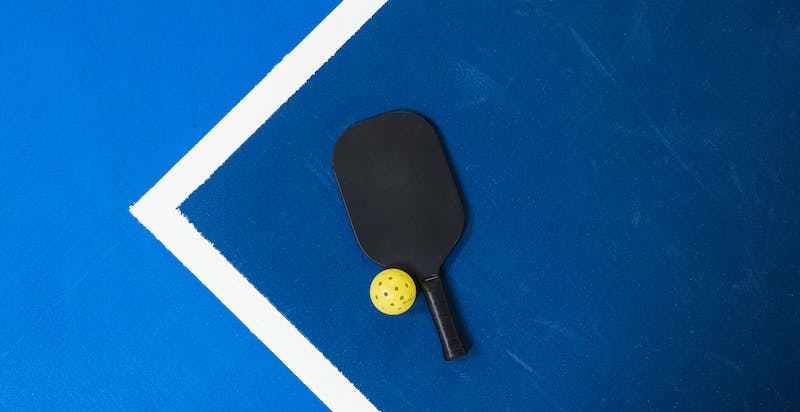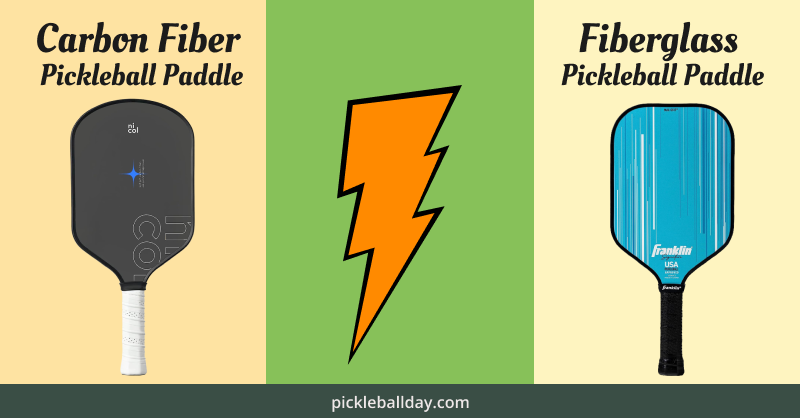As one of the most popular sports, pickleball cuts across the ages, with active participants hitting 4.3 million as of 2020. The exponential growth, describing it as a fast-rising sport, has led to the establishment of pickleball tournaments with participants from across the globe.
Your performance in any tournament is greatly determined by the pickleball paddle you choose. The recent technological advancement in developing sophisticated pickleball paddles has made it challenging for beginners to pick the ideal pickleball paddle.
In this article, we put our foot forward by highlighting some of the key characteristics that distinguish between carbon fiber and fiberglass pickleball paddles.
Table of Contents
- 1 Main Differences Between Carbon Fiber and Fiberglass Pickleball Paddles
- 2 Comparisons of Pros: Between Carbon Fiber and Fiberglass Pickleball Paddles
- 3 Comparisons of Cons: Between Carbon Fiber and Fiberglass Pickleball Paddles
- 4 Which Will Suit Beginners: Carbon Fiber vs. Fiberglass Paddle
- 5 Which Paddles do Professional Players Prefer: Carbon Fiber or Fiberglass
- 6 Final Thoughts
Main Differences Between Carbon Fiber and Fiberglass Pickleball Paddles
The maneuverability, power, and pop of carbon fiber and fiberglass pickleball paddles are determined by the following factors:
- Material Types
- Budget and Cost
- Weight
- Durability
- Edge Guard vs. Edgeless
- Textured Surface
- Noise
- Grip
Material Types
Carbon fiber is stiff, providing more control, ideal for players looking for fewer mis-hits. Though you will experience a loss of power using this paddle, you’ll have unmatched ball control.
The returns can be reciprocated for hard shots or changed from speeding shots to soft returns. In contrast, the fiberglass pickleball paddle offers more power, though it’s not as strong.
Fiberglass paddles provide a responsive, durable, smooth, and strong paddle ideal for every player. Commonly referred to as a composite pickleball paddle, the fiberglass paddle is made from several hybrid materials.
Budget and Cost
Before setting foot on the pickleball court, you’ll have to incur the cost of buying the necessary gear, and one of those is the paddle. Generally, the cost of a pickleball paddle varies between $13 and $145, with a wooden paddle being the cheapest.
Carbon and fiberglass paddles are made from low-end materials and cost roughly $60 and $45. A cheaper option may require you to replace the paddle every few months, which becomes costly if you’re in it for the long haul.
For a good fiberglass pickleball paddle, expect to pay at least $50, with a price range not exceeding $145 for top-end paddles.
Weight
The weight of a pickleball paddle is the most important aspect of choosing a paddle as a beginner. And while you might be tempted to go for heavier paddles because of the extra power, lighter paddles give you the exceptional maneuverability and control that they offer.
As a beginner, it would be wiser to choose a mid-weight paddle. The drawbacks of heavy and light pickleball paddles are their increased stress on the shoulders and elbows and their lower power output, respectively.
The weight of the pickleball paddle ranges from 7 to 14 oz, divided into categories of lightweight (7 to 7.3 oz), mid-weight (7.3 to 8.3 oz), and heavyweight (over 8.3 oz).

Durability
The durability of a pickleball paddle depends on several issues, including how often you play, environmental conditions, banging the paddle, etc. Generally, a pickleball paddle should last approximately 3 years before its performance degrades, courtesy of losing its pop.
Essentially, fiberglass is considered more durable in determining durability compared to carbon fiber. However, further studies are needed to establish carbon fiber’s durability as it’s less commonly used.
The compound used in making the honeycomb determines the paddle’s sustainability against unfavorable environmental conditions and the wear and tear of daily activity.
The technological innovation that replaces the polymer honeycomb, which has the propensity to become unglued, develop dead spots, and eventually break down with fiber rods, has been lauded as the best option.
Edge Guard vs. Edgeless
Whether you pick an edgeless or edge guard, it greatly relies on the intent to prolong the lifetime of your pickleball paddle. While an edgeless paddle offers a larger hitting surface area, it’s more susceptible to damage.
The edge guard paddle will be more efficient for a pro to avoid hitting the ball on the edge, resulting in a miss-hit—though the best players prefer the edgeless paddle. The edge tape also offers protection to the honeycomb core from delamination.
Whether a paddle is edgeless or with an edge guard, it is not predicated on both carbon fiber and fiberglass pickleball paddles and varies across the board, enticing the player’s preference. A survey of pickleball enthusiasts indicates that less than 10% of players opt for edgeless paddles.
Textured Surface
The carbon fiber pickleball paddles have a grainy textured surface that enhances control and gives room for a lot more spin. Fiberglass paddles, on the other hand, aside from the spin, offer additional power.
The fiberglass paddle face absorbs the ball’s energy and relays it right back because of its flexibility. It dramatically reduces the sweet spot size compared to carbon fiber.
The carbon fiber pickleball paddles spread the ball’s energy across the surface to the handle, allowing for a larger sweet spot and better feel. However, you’ll need more power to execute your serves and returns.
Noise
Given the textured composition, fiberglass pickleball paddles offer more pop by concentrating the ball’s energy on the paddle core.
The paddle core is what determines the unique sound the paddle produces. In most cases, the honeycomb cores are made from polymer, producing a relatively lower sound than an aluminum or Nomex core. Fiberglass emits a lot more noise than carbon fiber paddles.
Grip
Your fingers’ grip around the handle is critical in picking a pickleball paddle. The back and forth during the game will occasionally lead to the paddle twisting or dislodging from your grip, losing your touch.
To avoid such hiccups, go for a well-fitted grip handle. You can understand the grip by measuring between the middle crease on your palm and the tip of your ring finger to determine your fit.
If you’re unsure between two picks, choose the smallest size. Ensure your index finger fits snuggly by inserting it between the palm heel and fingertips. You’ll know that the grip is small when you have to shift your fingers for your index finger to fit in between.
Overlooking this vital component leads to discomforts like the tennis elbow. The handle width and length are left to the discretion of the manufacturer. It isn’t a determinant factor, but it’s essential in picking a paddle that gives control to your shots.
Comparisons of Pros: Between Carbon Fiber and Fiberglass Pickleball Paddles
| Pros of Carbon Fiber | Pros of Fiberglass |
| Lighter | Powerful performance |
| Increased control | More spin-Given its soft touch |
| Largest sweet spot | Flexible |
| High deflection rate | Pocket-friendly |
| Minimize the twisting of the paddle in hand |
Comparisons of Cons: Between Carbon Fiber and Fiberglass Pickleball Paddles
| Cons of Carbon Fiber | Cons of Fiberglass |
| Stiff materials | Emit noise or more pop |
| Less ability to resist deformation and deflection | Heavy |
| Limited number in the market | Not strong |
| Lacks the power compared to other materials | Less sweet spot |
| Expensive | Chip and peels easily |
| Deteriorate faster and decay at a higher rate |
Which Will Suit Beginners: Carbon Fiber vs. Fiberglass Paddle
Lightweight paddles require a faster swing speed and reaction time, making them more suitable for professional athletes.
As a beginner, you’d be more inclined to have a paddle that exhibits the quality of your performance and gives you more control over the placement of your shots.
Ideally, a heavier pickleball paddle is suitable for beginners, given the ease of control with minimal strength, but they may be more likely to get injured. A paddle that offers an in-between feel weighs between 7.4 and 7.8 oz, which is the mid-weight paddle.
Which Paddles do Professional Players Prefer: Carbon Fiber or Fiberglass
A professional player’s pick may be dictated by several variables, including endorsement deals. For example, most professional players, including Jonny Pickleball Andrews or Ansboury Sarah, would rather go for carbon fiber or graphite paddles because they provide an exceptional sense of touch and feel.
Precious shots, control, finesse at the kitchen line, deep returns, and serves- all these features characterize the carbon fiber pickleball paddle. While the fiberglass paddles are more geared towards attaining accuracy, they’re not a darling for advanced players.
Final Thoughts
With this guide distinguishing between carbon fiber and fiberglass, you’ll be able to pick out a pickleball paddle like an experienced player. Weighing all the factors that come into play, you should buy a pickleball paddle that complements your skills and ability on the court.


